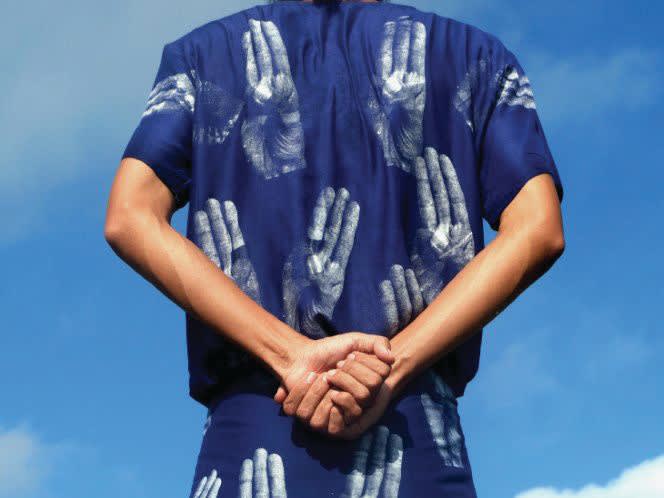Ninety-five days in prison have only strengthened Moe Satt’s resolve to resist the Tatmadaw military dictatorship that seized control of Myanmar in a coup this February.
One of the country’s best-known artists, Moe Satt was detained during a protest on Armed Forces Day on 27 March. He says that after a car of police and soldiers arrived at the protest, “we ran away and hid in a nearby building. But they searched the entire area and the whole building from the ground floor to the top; we were hiding on the ninth floor. Finally, they found us. After a few hours at a police station and two nights in the Interrogation Camp [a military jail], I spent 38 days in an isolation ward at Insein [Yangon’s notorious central prison], then 55 days in a meditation ward there.”
Moe Satt and his companions were charged with Myanmar’s Code 505-A outlawing reports or rumours that are damaging to the military. He was arrested along with eight others—“five poets, one designer and two young people”—during a year of protests that has also seen the detention of film directors, musicians, actors and actresses, writers, and the rector of a university of art and culture, he says.
As of late October, there have been 7,016 political arrests by the Tatmadaw since the coup, and 1,196 have been killed by the military, according to the Assistance Association for Political Prisoners (Burma). “Many artists have joined this revolution,” Moe Satt says. “That’s why some were arrested, some have run away and hidden, and some are in the forest, to join armed groups.”
Conditions in the Panopticon-style colonial jail built in 1887 were grim, the artist says. “Prison in Myanmar is the worst in the world. No human rights at all. The toilet has no door. We’re not allowed to use pen and paper to write. We can’t connect with our families apart from one letter once a month. There is no telephone in the prison.” He describes it as a “terrible experience”. Moe Satt’s 20ft x 50ft cell held 50 to 70 people, “How can anyone sleep with 2ft x 6ft per person? We joked that a grave is much bigger.”
Art was far from his mind during that period. “I had no time to think about art. I had to face my difficult life in prison. After coming out, I needed time to digest those experiences. Later, I will try to make some work related to my prison life,” he says, adding that he has already begun exploring this, using the prison uniforms and rations as inspiration.
Moe Satt was previously detained after a performance piece in 2012, although he describes that encounter as only “a few hours in a police station and charged for public action without a permit”. He says: “I’ve been arrested several times for my public performances. But this time was totally different. This was the first time I was in prison. I’m proud of myself as a mini political prisoner.”
His release on 30 June returned Moe Satt to the daily difficulties of life in Myanmar post-coup, with internet and banking blackouts, economic devastation, vicious waves of Covid-19, and a constant threat of random military violence. Following the coup, he says, “the night was not safe. Police can come to your house any time and search without a warrant. If you do not open the door, they can destroy your door and enter your room and beat you and arrest you.”
Still, he says, the “civil disobedience movement held strong. All the galleries shut down and artists joined the protests on the streets.” The Association of Myanmar Contemporary Arts (AMCA) “organised an ‘Artists’ Street’ behind the high court and near city hall, and occupied that street for a week. Painters, musicians, poets, writers, cartoonists all gathered in Artists’ Street and made art against the junta. We also sold art on the street and later donated the money to whatever the revolution needed.” Moe Satt says the government tried in June to reestablish normalcy by reopening the National University of Arts and Culture, with campuses in Yangon and Madalas City, after some 70% of instructors and most students departed to join the CDM. However, it attracted neither teachers nor students.
Exporting work remains a challenge for Myanmar’s artists. Since his release, Moe Satt has been included in shows at Hong Kong’s Goethe Institut (closed 23 October) and Tai Kwun Contemporary (until 1 January 2022), and at Singapore’s Artspace@Helutrans (closed 17 October). An online exhibition with the UK’s Inventory Platform screened a digital performance of Moe Satt cooking prison food. He mostly sends work online, since “the post can be very censorious”, he says.
Receiving payment presents another hurdle. “It is very difficult to withdraw money from the bank, with the banking system very limited since the military coup. Some cash machines limit the withdrawal amounts to $200 to $500 to a week,” while most have shut down. “That’s why brokers emerged, who are connected with a general or a bank, and can help withdraw the money but with a 7% charge.”
A number of artists have left Myanmar, and the exiled branch of the AMCA is raising relief supplies and visibility for those opting to remain and fight.
“We ask of the art world to please stay with us. Support Myanmar and invite Myanmar artists to join your exhibitions. Please give us a chance to show Myanmar artists’ work to the world,” Moe Satt says.


